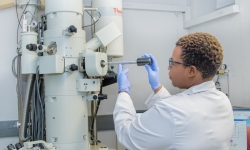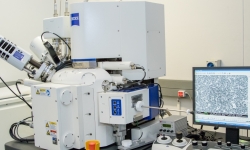DSI-CSIR National Centre for Nanostructured Materials: Characterisation facility
The National Centre for Nanostructured Materials was launched in 2007 as part of the implementation of government’s National Nanotechnology Strategy. In the past decade, the centre has undertaken innovative research on nanostructured materials and established an extensive research network with key local and international research organisations. The centre is well equipped with cutting-edge scaling up, polymer processing, characterisation and testing facilities, funded by the Department of Science and Innovation (DSI).
Empowering materials researchers
One of the key facilities that has enabled the CSIR over the past 10 years to conduct world-class research and development in the field of nanotechnology, is the characterisation facility. It is a multi-user, public instrumentation facility for materials research ranging from nanotechnology to biology and medicine. It houses advanced equipment and capabilities for comprehensive analysis of a wide range of functional materials as well as polymer testing.
The main purpose of this facility is to provide support to the CSIR’s multidisciplinary researchers while also offering characterisation services using the facility and its sophisticated equipment, to academia, industries and national laboratories. Researchers at the facility provide one-on-one equipment training to frequent users, staff and students that seek characterisation skills and knowledge in support of their research and educational goals.
Characterising the structure of materials at atomic and molecular levels
The characterisation facility comprises a suite of rooms specifically designed to facilitate world-class measurement techniques. Its characterisation and testing capabilities include microscopy via electron and ion beams made possible by scanning electron, transmission electron as well as the focussed ion beam scanning electron microscopes. These imaging techniques are used to characterise the structure of materials at atomic and molecular levels, so that scientists can understand how changes in structure translates into improved properties. The focussed ion beam scanning electron microscope in particular enables accurate milling (etching) of nanometre-thin layers of material at a time.
The facility team assists with sample preparation using in-house sample coating systems that include sputter and carbon coaters.
Equipped to investigate and understand the truly tiny
The facility boasts world-class equipment to obtain ultra-thin sections, essential for the transmission of electron microscopy from hard materials (focused ion beam milling) or soft polymers (cryo-ultramicrotomy).
Within the broad category of optical techniques, the facility offers a wide range of spectroscopic capabilities including ultra-violet visible near infra-red radiation, Raman, Fourier Transform Infrared, photoluminescence as well as dynamic light scattering and ellipsometry.
Various thermal characterisation tools with different capabilities, tailored to client’s specific needs, are also available in the facility, including tools for thermogravimetric analysis, differential scanning calorimetry, dynamic mechanical analyses, and measurement of rheological properties of a material.
X-ray techniques such as X-ray diffraction and small angle X-ray scattering are used for atomic structure analysis. In addition to X-ray techniques, surface analysis services are also offered via atomic force microscope and BET/Chemi- and Physi-sorption.
Other characterisation and testing capabilities in the facility include elemental and chemical imaging, including depth profiling; ion chromatography coupled with inductively coupled plasma mass spectrometry; electron spin resonance; as well as numerous polymer testing tools.
Fast facts
- The facility is engaged in collaborative research projects with outside industrial players such as SAPPI, the global provider of sustainable woodfibre products and solutions. It also works closely with the University of South Africa and Nelson Mandela University.
- The facility is engaging with potential partners, such as the Sefako Makgatho Health Sciences University, to improve service delivery.
- As one of the best equipped scientific facilities in South Africa, the facility is frequently visited by visiting scientists, community groups, learners, students and teachers.
For bookings and prices, please click here.





